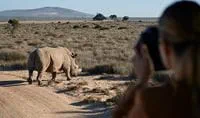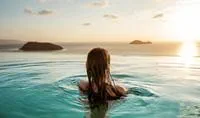An insight from our guide in the Galapagos
Naturalist guide Klaus takes us through the running of a typical day aboard a Galapagos cruise ship:
Read more
A regular day starts with a wakeup call of soft music and some location information, from the weather conditions to the coordinates. Some days an optional earlier wakeup call may be chosen so you can watch the sunrise over the ocean and see the passing sea birds from the observation decks. Then a buffet breakfast is served before disembarking for the morning's walk. Knowledgeable guides will lead their small group, frequently stopping to talk about the natural history of Galapagos wildlife, to observe up close natural behaviour of the animals, as well as to talk about the incredible geology and landscapes on the islands. Mid-morning, the guests will have all returned on board to gear up for the aquatic activities, when temperatures are also a bit warmer. Some guests may go snorkeling, with beginner's snorkeling from the beach and the more confident snorkellers can opt to snorkel at sites that require a Zodiac boat transfer further out to see wildlife from Green Turtles or Reef Sharks. Others may choose to sign up for kayaking where approved by the park, or simply enjoy lying on a white sandy beach enjoying the sunshine. By mid-day, all guests have returned to the boat and lunch is served. During the cruise, the expedition leader will organize special naturalist lectures and these generally take place before lunch in one of the lecture rooms. Lunch is a superb buffet, with different culinary flavors each day.
For the afternoon, the ship will have relocated to another island. We flip the order of activities, starting with a beach or snorkeling before preparing for the afternoon walk. Before sunset, all groups will be back on board and a sunset cocktail can be enjoyed before a briefing by the head naturalist. Then dinner is served, this time not a buffet but à la carte, with enough options to please different diets and interests.
After dinner, if conditions are favourable, some guests may join one of the naturalist guides on the outer decks for some spectacular stargazing. This is the end of yet another magical day in Galapagos.
Read more-
A maximum of 75,000 visitors a year can visit the Galapagos Islands, which is roughly the same number of football fans that fit in Manchester Stadium on match day.
-
There are less than 2,000 Flightless Cormorants on the planet, making them one of the world’s rarest birds.
-
The famous Galapagos Marine Iguana can live on land and in the sea, watching them dive to depths of up to 30 feet is quite a sight.
-
Located around 600 miles off the coast of Ecuador, the Galapagos Islands can be combined with an Amazon rainforest adventure or a visit to Peru’s magnificent Inca Ruins of Machu Picchu.
-
The blue-footed booby is an adorable bird with electric blue feet, they have a fantastic courtship dance where they prance about, spread their wings and make a bow!
-
The Galapagos Islands were discovered in 1535 when a ship was blown off course; Charles Darwin actually arrived 300 years later when his visit resulted in his theory of evolution published in The Origin of the Species.
-
Just 3% of the Galapagos Islands are populated; the rest is designated National Park and remains one of the most protected wildlife areas in the world.
-
![Galapagos Islands]() Destination
Destination
Galapagos Islands
Famous for its unique and fearless wildlife, the Galapagos Islands, just off the coast of Ecuador, are best experienced by cruise. You can swim with sea lions, float eye-to-eye with a penguin, stand next to a blue-footed booby feeding its young, watch a giant tortoise lumbering through a cactus forest and try to dodge the iguanas scurrying over the lava.
Meet our Galapagos specialists
Call us on 212 372 7009 to start planning your vacation
Why Scott Dunn?
Unique to You

- We listen to your travel goals and craft unique trips that are personalized to you.
- We’re with you every step of your life’s travel journey, from honeymoons to family trips and beyond.
Seamless Service

- Global offices in the UK, US, and Singapore for 24/7 seamless service.
- We offer flexibility if your plans change so you can book with confidence and peace of mind.
Carefully Curated Collection

- We’ve curated an elevated collection of accommodation, experiences, and guides.
- Committed to fostering close global relationships to continue bringing you unique experiences.
Luxury in Every Sense

- We deliver a sense of luxury that matters most to you.
- Awarded Condé Nast Traveler’s Top Travel Specialists in the World 12 years in a row.





